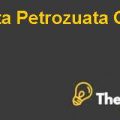
Donor Program Sale Program:
The Donor program is a good idea. Hewlett foundation got the shares from Mr. Hewlett which was worth $4.1 billion; the sales of shares are in order to diversify their portfolio. 70 per cent of the portfolio is put into the index funds while the other 30% goes into the active managers, which is an effective policy and helps the foundation in diversifying its portfolio to limit the risk of investment.
Financial Issue:
The financial issues that persist in Hewlett Foundation are that they are needed to maintain 5.5 per cent asset base to stay tax-exempt and if the asset base increases over 5.5 per cent they would have to pay taxes on it which will have an impact on the returns which are needed to pay out. The requirement of Hewlett Foundation is to pay out at least 5 percent per year due to which Hewlett Foundation needs to create a new asset allocation policy to address all the issues and problems and to keep paying out 5 per cent and maintaining the asset base to 5.5 per cent. Hewlett Foundation has no other way to generate the revenue and income except investing like other endowed institutions like private colleges.
Hewlett Foundation needs to define and implement a new strategy of investment to tackle all the issues and to pursue all the objectives and to preserve and grow its capital in real terms.
Hewlett Foundation Policy of Managing its Assets:
Managing the assets through making decisions about the mix and policy, achieving the objectives of investments, allocating the asset for individuals and institutions and balancing the risk against the performance is very crucial for Hewlett Foundation. It is very important find out the strengths, weaknesses, opportunities and the threats in the choice of making an investment like the choice between debts versus equity, domestic versus international, growth versus safety, to maximize the return at a given level of risk.
The Hewlett Foundation manages its assets through maintaining the asset base with a well-diversified portfolio to minimize the risk and getting the desired rate of return. Hewlett Foundation monitors its portfolio by comparing the performance to the benchmarks which gives an idea on the performance which helps in the improvement and better decision-making.
Hewlett Foundation also compares its performance with the different stocks with similar risk to identify the returns on the investment which also gives an idea on the current performance and the possible ways to improve it. Moreover, Hewlett Foundation also compares to returns to the similar investors with similar parameters to identify the improvements it can make through better decision making by gaining enough knowledge.
Another way in managing the assets Hewlett Foundation has adopted is to identify if the return on investment has exceeded the 5 per cent inflation rate which has the ability to appraise the performance of the investment and has it returned the required rate.
Hewlett Foundation has a compensation plan to motivate the management in making the best decision in the interest of the Foundation. The salary of the directors consists of the base salary and a bonus based on a quantitative measure and also through the qualitative evaluation which is very important to motivate the directors and enhance the performance of the Foundation. The quantitative component of the salary is based on the performance of the rolling three-year average return of the Hewlett Foundation portfolio relative to the composite benchmark. The compensation received by the management is the competitive market compensation and the bonus is not subject to claw back when the Foundation isn’t performing well.
Hewlett Foundation Long term spending:
The proposed allocation isn’t adequate to meet long term spending with the payout of 5 per cent. HF has the option to buy fixed income or take more risks to meet the long term spending payout of 5 per cent but there is a possibility that HF doesn’t have enough asset bases while the forecast of TIPS is only 4%.
Proposal to double to 20% the allocation to Absolute Return Strategies:
I do not agree with the proposal of doubling the allocation to absolute strategies to 20 per cent because it will make the policy more volatile, even though it has the ability to give bigger returns but can also face huge losses and can outperform the t-bills. The investment will also twice the amount and will be extremely risky..............................
Investment Policy at the Hewlett Foundation (2005) Harvard Case Solution & Analysis
This is just a sample partial case solution. Please place the order on the website to order your own originally done case solution.













